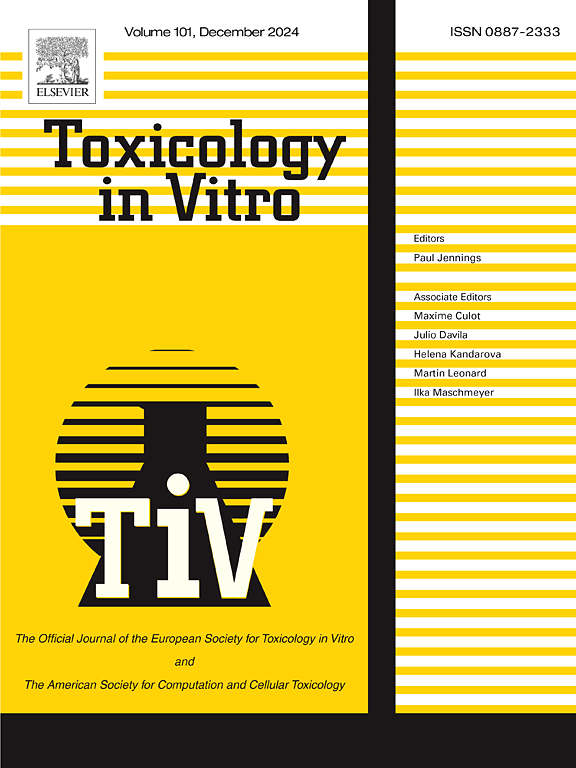姜黄素负载的乳化纳米粒子通过 p53 信号通路诱导胰腺癌细胞系 PANC-1 的细胞凋亡。
IF 2.6
3区 医学
Q3 TOXICOLOGY
引用次数: 0
摘要
胰腺癌是一个全球性的健康问题,预后不良,治疗方案有限,患者存活率低。因此,探索新的治疗方法至关重要。姜黄素有望治疗胰腺癌。姜黄素具有通过 p53 途径促进细胞凋亡的抗癌特性。然而,姜黄素的主要缺点是不良反应和生物利用率低,而通过纳米颗粒输送姜黄素可以提高其治疗效果。载姜黄素的乳化纳米粒子(CurEm)已在结直肠癌、肝癌和前列腺癌中显示出前景。本研究旨在评估 CurEm 在胰腺癌细胞系 PANC-1 中的抗癌潜力。CurEm 对 PANC-1 细胞的细胞毒性作用呈剂量和时间依赖性。所选剂量为 30 μM 的 CurEm 会导致 PANC-1 细胞出现球形形态,而集落形成试验和划痕试验则分别显示出显著的生长抑制和迁移能力下降。细胞周期分析表明 CurEm 能诱导 PANC-1 细胞 G2/M 停滞。与未处理组相比,经 CurEm 处理的 PANC-1 细胞的 p53 和 Caspase 3 基因明显增加,而 Bcl-2 基因则明显减少。Western 印迹结果显示了与 qPCR 分析平行的 Bcl-2 蛋白水平。有趣的是,我们发现 CurEm 处理的 PANC-1 细胞中 p53 蛋白水平较低。这些发现揭示了 CurEm 作为一种有效、稳定的胰腺癌治疗方法的潜力。本文章由计算机程序翻译,如有差异,请以英文原文为准。
Curcumin-loaded emulsome nanoparticles induces apoptosis through p53 signaling pathway in pancreatic cancer cell line PANC-1
Pancreatic cancer is a global health problem with a poor prognosis, limited treatment options and low survival rates of patients. Thus, the exploration of novel treatment approaches is crucial. Curcumin shows promise in pancreatic cancer. Curcumin has anticancer properties promoting apoptosis through the p53 pathway. However, adverse effects and low bioavailability are curcumin's main drawbacks and its delivery by nanoparticles could improve its effectiveness as a treatment option. Curcumin-loaded emulsome nanoparticles (CurEm) have shown promise in colorectal, hepatocellular, and prostate cancers. This study aims to evaluate the anticancer potential of CurEm in pancreatic cancer cell line PANC-1. The cytotoxic effects of CurEm on PANC-1 cells show cytotoxicity in dose and time-dependent manner. The selected dose 30 μM CurEm resulted spheroidal morphology in PANC-1 cells and colony forming and scratch assay conducted demonstrated significant growth inhibition and decrease in migration ability, respectively. Cell cycle analysis shows that CurEm induces G2/M arrest in PANC-1 cells. CurEm-treated PANC-1 cells showed a significant increase in p53 and Caspase 3 genes, while a significant decrease in Bcl-2 genes compared to untreated group. Western blot results showed parallel results to qPCR analysis for Bcl-2 protein levels. Interestingly, we saw low p53 protein levels in CurEm-treated PANC-1 cells. These findings shed light on the potential of CurEm as an effective and stable therapeutic approach for pancreatic cancer.
求助全文
通过发布文献求助,成功后即可免费获取论文全文。
去求助
来源期刊

Toxicology in Vitro
医学-毒理学
CiteScore
6.50
自引率
3.10%
发文量
181
审稿时长
65 days
期刊介绍:
Toxicology in Vitro publishes original research papers and reviews on the application and use of in vitro systems for assessing or predicting the toxic effects of chemicals and elucidating their mechanisms of action. These in vitro techniques include utilizing cell or tissue cultures, isolated cells, tissue slices, subcellular fractions, transgenic cell cultures, and cells from transgenic organisms, as well as in silico modelling. The Journal will focus on investigations that involve the development and validation of new in vitro methods, e.g. for prediction of toxic effects based on traditional and in silico modelling; on the use of methods in high-throughput toxicology and pharmacology; elucidation of mechanisms of toxic action; the application of genomics, transcriptomics and proteomics in toxicology, as well as on comparative studies that characterise the relationship between in vitro and in vivo findings. The Journal strongly encourages the submission of manuscripts that focus on the development of in vitro methods, their practical applications and regulatory use (e.g. in the areas of food components cosmetics, pharmaceuticals, pesticides, and industrial chemicals). Toxicology in Vitro discourages papers that record reporting on toxicological effects from materials, such as plant extracts or herbal medicines, that have not been chemically characterized.
 求助内容:
求助内容: 应助结果提醒方式:
应助结果提醒方式:


